HOT SHOT 7, 8- PRACTICE SKETCHING THE OUTLINE AND THE BLIND CONTOUR
We are now into the demos! This is where I’ll be showing and explaining in depth a few of the things that have made my sketching life much easier. In this particular post, I’ll be dealing with the OUTLINE and something I discovered from a 1985 American Artist Magazine, called-“The Blind Contour”. The Blind Contour actually improved my eye-hand co-ordination more than any other technique!
But before we get going on HOT SHOT 7 & 8, please click HERE if you missed HOT SHOT 6.
HOT SHOT 7
There are many ways to start a sketch. You can start by doing simple outlines of the subject or object before you. This is the contour of the object. This is a good way to really get going with a simplified sketch. Here you don’t really consider detail or tones. Your main focus is the outline. A good way of training your ability to do this is, is to do something I’ll treat on number 8 called the blind contour.
The outlines are not really outlined but we have to force our eyes to see the line that goes right round the thing we are about to sketch. Being able to quickly see this and put it down as accurately as possible is a very good way to start sketching in full force! Just the outline! When starting this for the first time, try not to pick your pencil and hand from the paper but just let it flow and move around your drawing surface.
HOT SHOT 8
To improve your sketching of outlines and contours. You can do what is called the blind contour. You get hold of your pen or pencil. Look at the object or subject you are about to sketch. Know where you are starting from and then just simply follow the contour of the object without looking back at the paper. Do this, until you feel you have completely covered the whole outline of the object. This is a great warm up exercise and really helps what you need as a great sketcher. It’s called your eye-hand co-ordination. You’ll be training your eyes, your most powerful weapon.
While in Nigeria around the 90’s -I discovered a publication of the AMERICAN ARTIST magazine, It was dated-February 1985-It was a SPECIAL DRAWING and PAINTING ISSUE. The Magazine simply changed the way I saw! I must have read it over and over-100 times or more.
One of the articles that really touched me was one by someone called Brook Temple, He wrote a simple straightforward article on “Exercises to improve your drawing skills”.
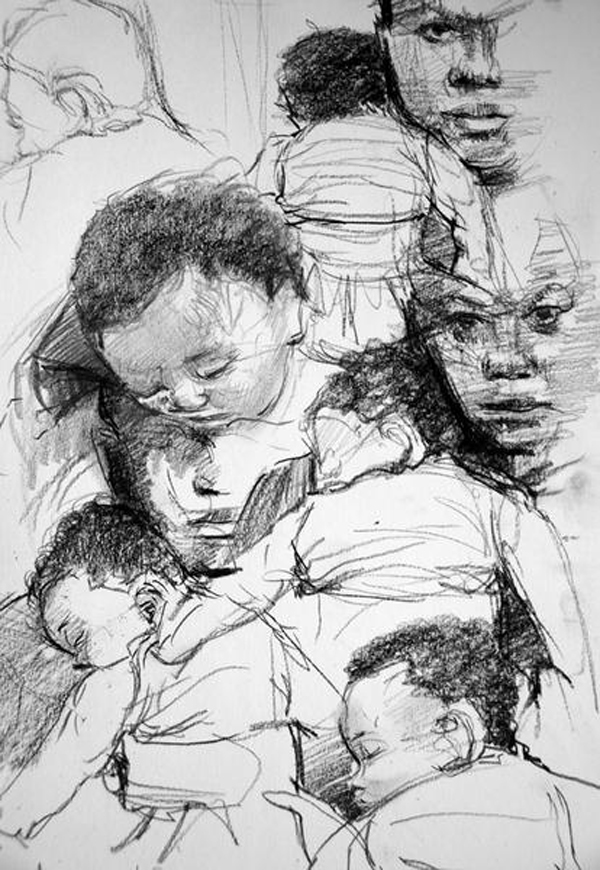
In all these sketches, it was my charcoal just going around the outlines of my sleeping daughter and myself
He mentioned Blind Contour as one of them and this is what he said, “Contour drawing is probably the most single important element in figure drawing and the closest thing to pure drawing. It is a strong confidence-builder because it co-ordinates hand, eye, and mind. If there is a secret in drawing, I believe it begins with contour drawing.”
He also said, “I use contour drawing throughout my classes because it is important as a tool in learning to SEE what is right there in front of you. If YOU can see it, YOU can draw it.“
This is his procedure: “We start by taking a soft charcoal pencil or a coloured crayon and drawing the outside contour of the figure without looking at the page. Now this may seem awkward at first; some people find it very hard not to look back and check the drawing. DON’T! In my class I monitor the eyes of my students to make sure their eyes are glued to the model for the duration of the pose, usually five minutes. Remember, If you cheat, you’re cheating yourself.“
Now, I remember reading this article and I was instantly hooked! I hope you can do this on a daily basis! Don’t worry if you stop, just get back at it again! I have been using this technique to improve ever since then and you can too!
I hope you are fired up by this post and if you are and you want to share, please do, or just comment or like with the Social media buttons below!
Tagged with: Adebanji Alade • American Artist Magazine • ball point pen • Brook Temple • charcoal • contours • outlines • sketchbook • Sketches • tombow dual brush pens
Filed under: Inspiration to sketch • Sketchbook • Sketching Tips
Like this post? Subscribe to my RSS feed and get loads more!
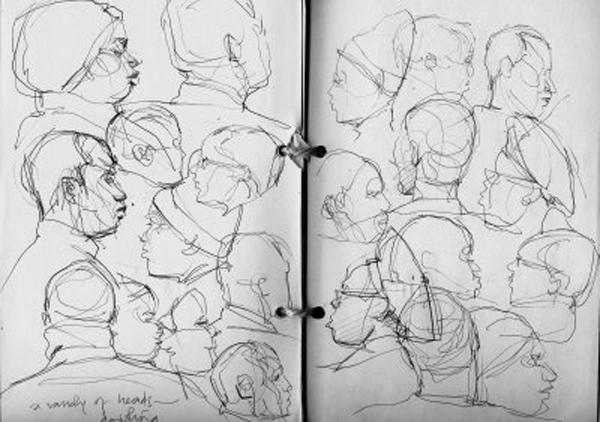
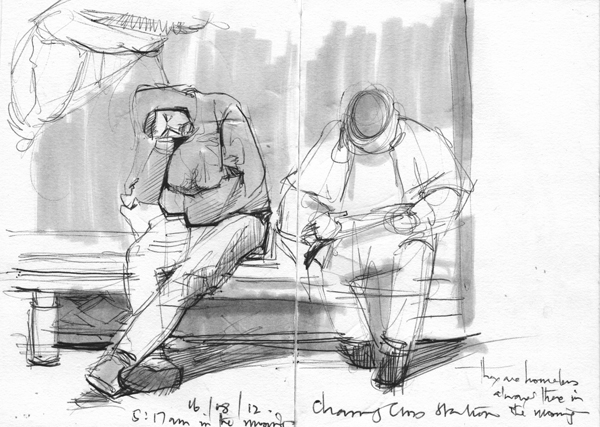
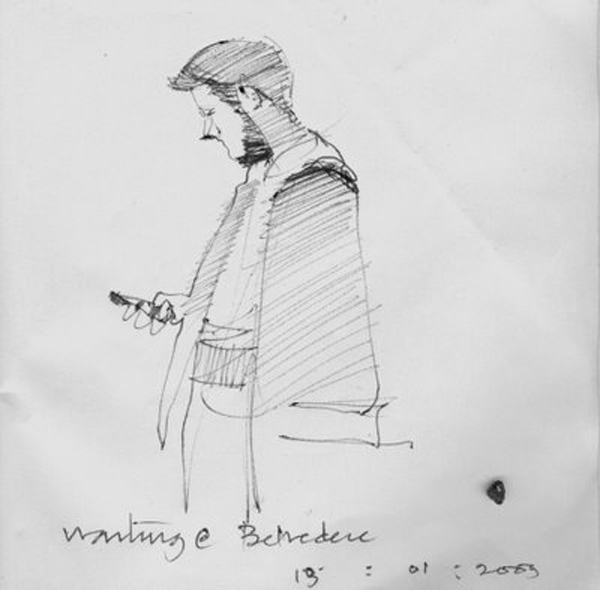
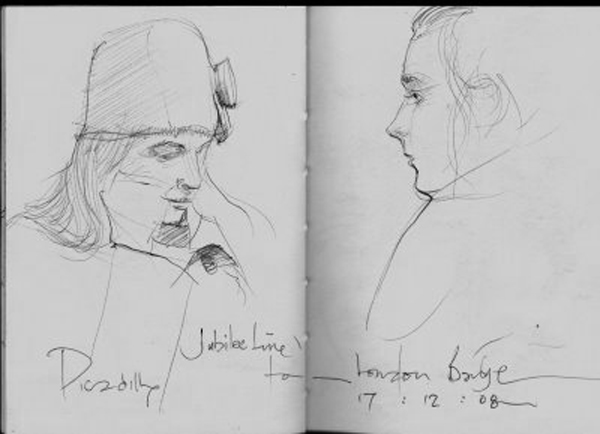

Adebanji, you are so right, this is the best exercise. I learned it from Peggi Kroll-Roberts, a wonderful American figure painter. I think I will do a lot of blind contour drawing tonight at life drawing. I love this new blog. Thank you! – Bobbi Heath
Brilliant Bobbi! I am happy you have learned this from Peggi, I discovered Peggi’s work from American Art magazines while in Nigeria and I still love her work-mainly her sense and understanding of colour!
Give it your HOT SHOT, I mean your best shot tonight!!!
I’ve heard (and read) of this technique a lot of times. I never dare to try it mostly because I didn’t understand the point of only looking at the model. Now, because of you, I understand, and I can’t wait to try. Thanks again. 🙂
Great Alizarine!!! Your comment has made my day!!! Just go for it! it’s a great technique!!
Like Alizarine, I never really understood the reason behind blind contour drawing so, thank you, for clarifying it for me. I LOVE your Hot Shot blog!
Thanks Serena! I’m glad you are loving it!
I cant thank you enough for having this for us who are learning. The time you are putting into this must be alot but it really taken as thank you for the time and the information.I cant wait to further go down this path you are leading us down,
Have a wonderful day,
Linda
Oh that’s so encouraging Linda, because it does take a lot of time but there’s no greater feeling than sharing knowledge to help someone out there! I have benefited from this sort of thing for years and it’s time to pay back!
This is so inspiring – I started out doing a lot of blind contour drawing, but then got out of the habit. I believe you are right about how important it is – and I feel like jumping on a train right now and getting into it!!
This blog is fabulous – thank you.
Thanks Evelyn! That’s the spirit! It’s all about getting back into the stream of things again and giving it a go! The rewards are always greatly beneficial!
I would like to suggest two books for everyone, Betty Edward, Drawing from the Right Side of the Brain and Bernard Chaet, The Art of Drawing, Yale University Press. Thanks for the memories.
Oh my! I’m really short of words! I’m so pleased to have you comment here Brook and thanks a million for the book reccomendations! Some really good books have be mentioned on this blog and I might have to open a section or page for them.
You are one of those people out there that have silently inspired me for years! Your article in The Amerrican Artist magazine changed everything I knew about drawing! So simple and straight forward! I’ll be sharing more of what I learned here, in some of later hot shots!
Thanks once again Brook!!!
Thank you for these great tipps. Very helpful stuff.
You are welcome Anne!
Thank you so much for this lesson. Trying it right now with my husband as model. Sharon smith
You are welcome Sharon, I am so happy to hear you’ve put this to practice!!!
This is wonderful, thank you so much. I watched the whole series this morning very helpful and inspirational. The Detroit Institute of Art has ‘Sketching in the Galleries” on Sundays. They provide easel, paper, pencil and Ben an artist to help you. I may head over there later. Thanks again I look forward o your next lesson.
Thanks Patrick- that’s the spirit! Just keep it going and flowing!!! It’s great that galleries have these programs running!
Only just found your site, and I’m so moved but watching you and your demo’s! So exciting and I feel as tho’ I have learnt already, so can hardly wait for your next blog!!
Thank You
Joy L
Joy-Thanks and I’m so excited to keep the posts coming. Stay tuned!!
Hello Adebanji,
Thank you for this new Sketching Blog! Last year I discovered The Art of Urban Sketching book in which you and many others feature!I just love that book and have read it cover to cover – it lead me to look you up as part of the London Urban Sketchers – I then went to the Urban Sketching day at Tate Modern on 19th January and met lots of other like minded people…what a joy! I’ve subsequently discovered your painting from that chilly day, which is lovely – I managed a couple of quick sketches outside and then retreated inside for a coffee! I am sorry we didn’t meet on that occasion, but this new blog is the next best thing….thank you for your enthusiasm and genuine passion for Art – you have a real gift for teaching. Thank you
It’s a shame I missed you on the day Sarah, I was so busy but didn’t want to miss out in the fun, so I rushed in to do a quick plein air sketch and I rushed back to the studio. I am glad you enjoy the new blog and I hope it helps you in some way to get better and better at sketching!
I am really enjoying your hotspots. I have not done blind contours for some time, thanks for reminding me how beneficial and fun they are. Looking forward to your future posts.
Thanks Don! Blind Contour is great and I hope you enjoy the other ones thst would be coming up! Stay tuned!
that’s amazing! this kind of tips is exactly what i’ve been looking for since so long time! in art books of my little town’s library here in Italy…and then i found it here in internet by chance!
i’m gonna study all your tips and try to put them in practice!!